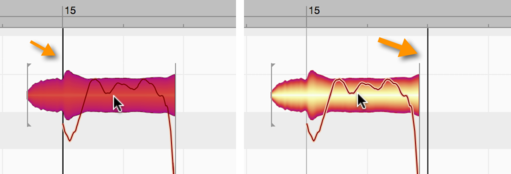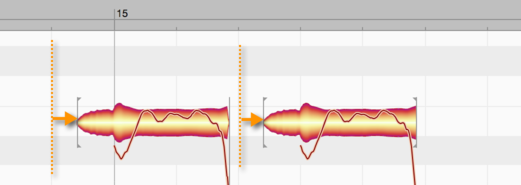Copying notes
To copy notes in Melodyne, first select the desired notes, then choose Copy from the Edit menu or the context menu of the Note Editor. To insert them, use the Paste command. The following points here need to be noted.
The selection, cursor and grid when copying
When you copy notes to the clipboard using the Copy command, you will notice that the cursor moves to the start of the selection, or, to be more precise, to the quarter-note (crotchet) on the Time Grid closest to the first note of the selection.
If, with the notes still selected, you use the Paste command, all that appears to happen is that the notes that were selected prior to the paste are now no longer selected and the cursor is now located just after the last of them.
In fact, however, the notes previously selected have been replaced by those on the clipboard. In other words, the notes have been copied onto themselves, with the copies replacing the originals. Admittedly, this may not sound particularly useful, but look at the position of the cursor: it is now aligned with the quarter-note on the Time Grid closest to the last copied note.

If you now execute a further Paste, the notes on the clipboard will be pasted a second time. This time, however, since no notes were selected, nothing will be replaced. Instead, the newly pasted notes will end up just after those that replaced the originals the first time round.
Their position is now determined by the cursor. And since, after the first paste, this was aligned with a quarter-note on the Time Grid (the first quarter-note after the pasted notes, to be specific), the effect of the second paste is that the original alignment of the notes relative to the gridlines is reproduced exactly, only further along the timeline. This behavior allows you to string together a succession of copies of the same passage, quickly and accurately – in order, for example, to create multiple iterations of a drum loop.

Based on what we have just seen, we can formulate the following rules:
- If any notes are selected when the Paste command is executed, these are replaced by the contents of the clipboard. The pasted notes are stretched or squeezed until they fit exactly the range from the beginning of the first to the end of the last note of the selection. This is illustrated here: on the left are the notes to be copied; in the centre, a single selected note, which serves as the destination of the copy; on the right is the result after the paste is performed: The selected destination note has been replaced and the pasted notes squeezed just enough for them to fit exactly the space it occupied.

- If when the Paste is executed no notes are selected, the cursor determines the point at which the pasted passage begins. The grid settings here play an important role: when copying notes to the clipboard, Melodyne remembers the distance between the first of the copied notes and the nearest grid line. When the paste is repeated at the new cursor position, the offset of the first pasted note to the gridline nearest to it will be exactly the same.

In other words, notes in Melodyne are not copied in such a way that they necessarily coincide with gridlines, because then the subtleties of expression would be lost. Instead, the notes copied retain their respective offsets to the grid. There is an exception, however, to this rule: if, instead of being calibrated in beats, the grid is calibrated in seconds (i.e. if you have selected “Sec” from the Time Grid Settings drop-down menu to the right of the Time Ruler), then the note (or first of a series of copied notes) will begin exactly at the cursor position, with no offset.
- After each paste, the cursor is moved to the first quarter-note following the most recent paste, making it easy to string together multiple iterations of the same passage. Obviously, if you wish, you can move the cursor by hand to some other point on the Time Ruler and make that, rather than the automatically selected quarter-note, the reference point for the next paste. You might want to do this, for instance, to introduce a pause between iterations.
- The pitch of the copied notes is always the same as that of the originals. This is even true when notes are selected, and therefore replaced, when the paste is performed. The length of the passage selected, in this case, is retained but the original pitch of the notes it contained is not. Of course, after performing the paste you can move the notes by hand to any pitches you like.
Tempo adjustment when copying: the Auto Stretch Switch
If notes are selected when the paste is performed, the inserted passage will be stretched or squeezed to fill the available space (i.e. that between the beginning of the first selected note and the end of the last) as we have already seen. But how is the tempo of the copied passage treated when the position of the paste is determined instead by the cursor?

If the tempo at the destination of the paste is different from that of the passage from which the notes were copied, it is the status of the Auto Stretch Switch that determines whether the pasted notes adjust to the tempo of the destination or retain their original tempo. If the Auto Stretch Switch is on, they adjust; if it is off, they do not. So unless you want to change the tempo at the cursor position, you should switch Auto Stretch on before performing the paste.
If the tempo of the source is different from that of destination, and the material on the clipboard is adjusted to the new tempo, the pasted version will obviously sound different to the original. If you want to avoid this happening, however, in the stand-alone implementation of Melodyne, you can copy not only the notes but also the tempo (including any sudden or gradual tempo changes within it) from the source to the destination. In this case, it makes no difference which you copy first: the notes or the tempo.
Copying in a multi-track context (without ARA)
In Melodyne studio you can see, select and edit notes from different tracks at the same time in the Note Editor – and even copy them. Provided after selecting the notes and executing the Copy command, you do not exit the Note Editor before performing the paste, the track assignments of the notes selected will be preserved. If, for example, you select a bar from the bass guitar track and a bar from the lead vocal track and then paste them simultaneously to a different point on the Time Ruler, the notes copied from the bass track will be pasted into the bass track, and those copied from the vocal track will be pasted into the vocal track.
If you wish to paste the copied notes into tracks other than the original ones, before performing the paste you must select the desired destination tracks by clicking the relevant track headers, holding the [Shift] and/or [Command] keys where necessary.
Here, the following rules apply:
- If there are the same number of destination tracks as source tracks, the notes will be copied accordingly; if the source tracks, for example, are numbered 1, 2 and 3 and the destination tracks 4, 5 and 6, the material copied from Track 1 will be pasted into Track 4, that from Track 2 into Track 5 and that from Track 3 into Track 6, as you would expect.
- If the material on the clipboard has been copied from multiple tracks but a single track has been selected as the destination, all the material will be pasted into that one track.
- If the material on the clipboard has been copied from a single track but multiple tracks have been selected as destinations, the same notes will be copied into all the destination tracks (duplicating the material, in other words).
- If no sensible correlation can be established between source and destination track(s), the Paste command will be grayed out.
The same rules apply if, instead of choosing Copy after making the selection, you choose Cut.